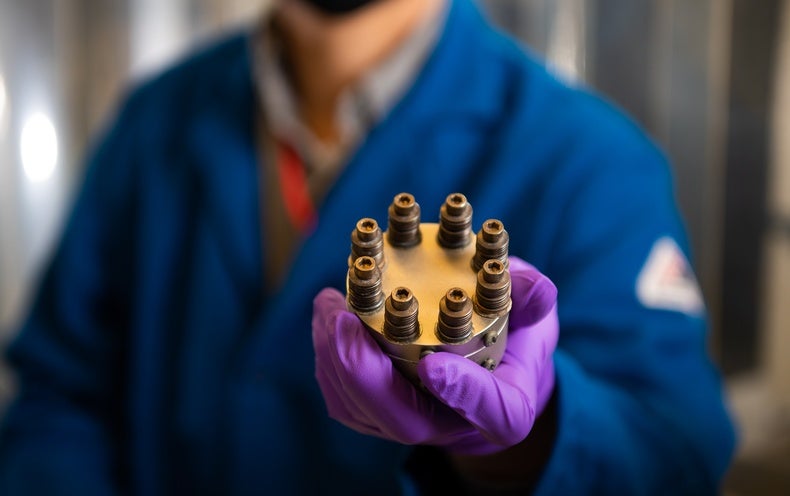During spring in the Pacific Northwest, meltwater from thawing snow rushes down rivers and the wind often blows hard. These forces spin the region’s many power turbines and generate a bounty of electricity at a time of mild temperatures and relatively low energy demand. But much of this seasonal surplus electricity—which could power air conditioners come summer—is lost because batteries cannot store it long enough.
Researchers at Pacific Northwest National Laboratory (PNNL), a Department of Energy national laboratory in Richland, Wash., are developing a battery that might solve this problem. In a recent paper published in Cell Reports Physical Science, they demonstrated how freezing and thawing a molten salt solution creates a rechargeable battery that can store energy cheaply and efficiently for weeks or months at a time. Such a capability is crucial to shifting the U.S. grid away from fossil fuels that release greenhouse gases and toward renewable energy. President Joe Biden has made it a goal to cut U.S. carbon emissions in half by 2030, which will necessitate a major ramp-up of wind, solar and other clean energy sources, as well as ways to store the energy they produce.
Most conventional batteries store energy as chemical reactions waiting to happen. When the battery is connected to an external circuit, electrons travel from one side of the battery to the other through that circuit, generating electricity. To compensate for the change, charged particles called ions move through the fluid, paste or solid material that separates the two sides of the battery. But even when the battery is not in use, the ions gradually diffuse across this material, which is called the electrolyte. As that happens over weeks or months, the battery loses energy. Some rechargeable batteries can lose almost a third of their stored charge in a single month.
“In our battery, we really tried to stop this condition of self-discharge,” says PNNL researcher Guosheng Li, who led the project. The electrolyte is made of a salt solution that is solid at ambient temperatures but becomes liquid when heated to 180 degrees Celsius—about the temperature at which cookies are baked. When the electrolyte is solid, the ions are locked in place, preventing self-discharge. Only when the electrolyte liquifies can the ions flow through the battery, allowing it to charge or discharge.
Creating a battery that can withstand repeated cycles of heating and cooling is no small feat. Temperature fluctuations cause the battery to expand and contract, and the researchers had to identify resilient materials that could tolerate these changes. “What we’ve seen before is a lot of active research to make sure you do not have to go through that thermal cycle,” says Vince Sprenkle, a strategic advisor in energy storage at PNNL and a co-author of the new paper. “We’re saying, ‘We want to go through it, and we want to be able to survive and use that as a key feature.’”
The result is a rechargeable battery made from relatively inexpensive materials that can store energy for extended periods. “It’s a great example of a promising long-duration energy-storage technology,” says Aurora Edington, policy director of the electricity industry association GridWise Alliance, who was not involved with this research. “I think we need to support those efforts and see how far we can take them to commercialization.”
The technology could be particularly useful in a place such as Alaska, where near-constant summer sunlight coincides with relatively low rates of energy use. A battery that can store energy for months could allow abundant summer solar power to fulfill winter electricity needs. “What is so attractive about the freeze-thaw battery is that seasonal shifting capability,” says Rob Roys, chief innovation officer at Launch Alaska, a nonprofit organization that works to accelerate the deployment of climate technologies in the state. Roys hopes to pilot the PNNL battery in a remote part of his state.
Heating the battery may be a challenge, especially in cold places. Even under mild conditions, the heating process requires energy equivalent to about 10 to 15 percent of the battery’s capacity, Li says. Later phases of the project will explore ways to lower the temperature requirements and incorporate a heating system into the battery itself. Such a feature would simplify the battery for the user and could potentially make it suitable for home or small-scale use.
Right now the experimental technology is aimed at utility-scale and industrial uses. Sprenkle envisions something like tractor-trailer truck containers with massive batteries inside, parked next to wind farms or solar arrays. The batteries would be charged on-site, allowed to cool and driven to facilities called substations, where the energy could be distributed through power lines as needed.
The PNNL team plans to continue developing the technology, but ultimately it will be up to industry to develop a commercial product. “Our job at the DOE is really to derisk new technologies,” Sprenkle says. “Industry will make the decision whether they think that it’s been derisked enough, and they will take that on and run with it.”
The DOE is working to shrink the lag that usually occurs between initial research demonstrations and commercialization of energy technologies. Although scientists began developing lithium-ion batteries in the 1970s, for example, the batteries did not end up in consumer products until around 1991 and were not incorporated into electrical grids until the late 2000s. Artificial intelligence and machine learning may help expedite the validation and testing process for new technologies, Sprenkle says, allowing researchers to model and predict a decade of battery performance without needing 10 years to collect the data.
Whether adoption will happen quickly enough to meet decarbonization targets is unclear. “If we are truly trying to hit 2030, 2035 decarbonization goals, all these technologies need to be accelerated by about a factor of five,” Sprenkle says. “You’re looking at developments that need to come online, be validated and ready to hand off in the next four to five years to really, truly have an impact.”
































